JPEG Image Steganography With Automatic Embedding Cost Learning
Abstract
A great challenge to steganography has arisen with the wide application of steganalysis methods based on convolutional neural networks (CNNs). To this end, embedding cost learning frameworks based on generative adversarial networks (GANs) has been proposed and achieved success for spatial image steganography. However, the application of GAN to JPEG steganography is still in the prototype stage; its antidetectability and training efficiency should be improved. In conventional steganography, research has shown that the side information calculated from the precover can be used to enhance security. However, it is hard to calculate the side information without the spatial domain image. In this work, an embedding cost learning framework for JPEG image steganography via a GAN (JS–GAN) has been proposed, the learned embedding cost can be further adjusted asymmetrically according to the estimated side information (ESI). Experimental results have demonstrated that the proposed method can automatically learn a content-adaptive embedding cost function, and using the ESI properly can effectively improve the security performance. For example, under the attack of a classic steganalyzer GFR with a quality factor of 75 and 0.4 bpnzAC, the proposed JS–GAN can increase the detection error by 2.58% over J-UNIWARD, and the ESI–aided version JS–GAN (ESI) can further increase the security performance by 11.25% over JS–GAN.
1. Introduction
JPEG steganography is a technology that aims at covert communication, through modifying the coefficients of the discrete cosine transform (DCT) of an innocuous JPEG image. By restricting the modification to the complex area or the low-frequency area of the DCT coefficients, content-adaptive steganographic schemes guarantee satisfactory antidetection performance, which has become a mainstream research direction. Since the Syndrome-Trellis Codes (STCs) [1] can embed a given payload with a minimal embedding impact, current research on content-adaptive steganography has mainly focused on how to design a reasonable embedding cost function [2–5].
In contrast, steganalysis methods try to detect whether the image has secret messages hidden in it. Conventional steganalysis methods are mainly based on statistical features with ensemble classifiers [6–8]. To further improve the detection performance, the selection channel has been incorporated for feature extraction [9, 10]. In recent years, steganalysis methods based on convolutional neural networks (CNNs) have been researched, initially in the spatial domain [11–14], and have also achieved success in the JPEG domain [15–18]. Current research has shown that a CNN–based steganalyzer can reduce the detection error dramatically compared with conventional steganalyzers, and the security of conventional steganography faces great challenges.
With the development of deep neural networks, recent work has proposed an automatic stegagography method to jointly train the encoder and decoder networks. The encoder can embed the message and generate an indistinguishable stego image. Then, the message can be recovered from the decoder. However, the security may reduced due to the larger capacity [19–22].
In the conventional steganographic scheme, the embedding cost function is designed heuristically, and the measurement of the distortion cannot be adjusted automatically according to the strategy of the steganalysis algorithm. Frameworks for automatically learning the embedding cost by adversarial training have been proposed and can achieve better performance than the conventional method in the spatial domain [23–25]. In [23], the authors proposed an automatic steganographic distortion learning framework with generative adversarial networks (ASDL–GANs), which can generate an embedding cost function for spatial steganography. U-Net and double-tanh function with GAN–based framework (UT–GAN) [24] further enhanced the security performance and training efficiency of the GAN–based steganographic method by incorporating a U-Net [26]-based generator and a double-tanh embedding simulator. The influence of high pass filters in the preprocessing layer of the discriminator was also investigated. Experiments show that UT–GAN can achieve a better performance than the conventional method. Steganographic pixelwise actions and rewards with reinforcement learning (SPAR–RL) [25] uses reinforcement learning to improve the loss function of GAN–based steganography, and experimental results show that it further improves the stable performance. Although embedding cost learning has been developed in the spatial domain, it is still in its initial stages in the JPEG domain. In our previous conference presentation [27], we proposed a JPEG steganography framework based on GAN to learn the embedding cost. Experimental results show that it can learn the adaptivity and achieve a performance comparable to that of the conventional methods. In [23], JPEG domain knowledge has been used to improve the performance.
To preserve the statistical model of the cover image, some steganography methods use the knowledge of the so-called precover [28]. The precover is the original spatial image before JPEG compression. In conventional methods, previous studies have shown that using asymmetric embedding, namely, +1 and −1 processes with different embedding costs, can further improve the security performance. Side-informed (SI) JPEG steganography calculates the rounding error of the DCT coefficients with respect to the compression step of the precover and then uses the rounding error as the SI to adjust the embedding cost for asymmetric embedding [29]. However, it is hard to obtain the SI without the precover, so the researcher tries to estimate the precover to calculate the estimated SI (ESI). In [30], a precover estimation method that uses series filters was proposed. The experimental results show that although it is hard to estimate the amplitude of the rounding error, the security performance can be improved by using the polarity of the estimated rounding error.
Although initial studies of the automatic embedding cost learning framework have shown that it can be content-adaptive, its security performance and training efficiency should be improved. In conventional steganography, the SI estimation is heuristically designed, and the precision of the estimation depends on experience and experiments. How to estimate the SI through CNN and adjust the embedding cost asymmetrically with the unprecise SI needs to be investigated.
- 1.
We further develop the GAN–based method of generating an embedding cost function for JPEG steganography. Unlike conventional hand-crafted cost functions, the proposed method can automatically learn the embedding cost via adversarial training.
- 2.
To solve the gradient-vanishing problem of the embedding simulator, we propose a gradient-descent–friendly embedding simulator to generate the modification map with a higher efficiency.
- 3.
Under the condition of lacking the uncompressed image, we propose a CNN–based SI estimation method. The estimated rounding error has been used as the SI for asymmetrical embedding to further improve the security performance.
The rest of this paper is organized as follows. In Section 2, we briefly introduce the basics of the proposed steganographic algorithm, which includes the concept of distortion minimization framework and SI JPEG steganography. A detailed description of the proposed GAN–based framework and the SI estimation method is given in Section 3. Section 4 presents the experimental setup and verifies the adaptivity of the proposed embedding scheme. The security performance of our proposed steganography under different payloads compared with the conventional methods is also shown in Section 4. Our conclusions and avenues for future research are presented in Section 5.
2. Preliminaries
2.1. Notation
In this article, the capital symbols stand for matrices, and i and j are used to index the elements of the matrices. The symbols C = (Ci,j), S = (Si,j) ∈ Rh×w represent the 8-bit grayscale cover image and its stego image of size h × w, respectively, where Si,j ∈ {max(Ci,j − 1, 0), Ci,j, min(Ci,j + 1, 255)}. p = (pi,j) denotes the embedding probability map. N = (ni,j) stands for a random matrix with a uniform distribution ranging from 0 to 1. M = (mi,j) stands for the modification map, where mi,j ∈ {−1, 0, 1}.
2.2. Distortion Minimization Framework
2.3. SI JPEG Steganography
3. The Proposed Cost Function Learning Framework for JPEG Steganography
In this section, we propose an embedding cost-learning framework for JPEG steganography based on GAN (JS–GAN). We conduct an ESI based on CNN to asymmetrically adjust the embedding cost to further improve the security, and the version which uses ESI as a help is referred to as JS–GAN (ESI).
3.1. JS–GAN
The overall architecture of the proposed JS–GAN is shown in Figure 1. The solid line and dashed line denote the forward and backpropagation, respectively. It is mainly composed of four modules: a generator, an embedding simulator, an IDCT module, and a discriminator. The training steps are described in Algorithm 1.
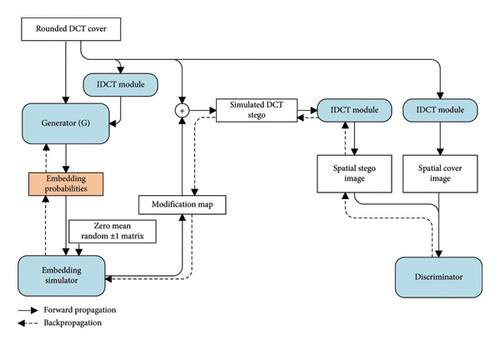
For an input of a rounded DCT matrix C, the pi, j ∈ [0, 1] denotes the corresponding embedding probability produced by the adversarially trained generator. Since the probabilities of increasing or decreasing Ci,j are equal, we set and the probability that Ci,j remains unchanged is . We also feed the spatial cover image converted from the rounded DCT matrix into the generator to improve the performance of our method.
-
Algorithm 1: Training steps of JS–GAN.
-
Require:
-
Rounded DCT matrix of the cover image.
-
Zero mean random ±1 matrix.
-
Step 1: Input the rounded DCT matrix of the cover image and the corresponding spatial cover image into the generator to obtain the embedding probability.
-
Step 2: Generate a modification map using the proposed embedding simulator.
-
Step 3: Add the modification map into the DCT coefficients’ matrix of the cover image to generate the DCT coefficients’ matrix of the stego image.
-
Step 4: Convert the cover and stego DCT coefficients’ matrix to the spatial image by using the IDCT module.
-
Step 5: Feed the spatial cover–stego pair into the discriminator to obtain the loss of the generator and discriminator.
-
Step 6: Update the parameters of the generator and discriminator alternately, using the gradient descent optimization algorithm of Adam to minimize the loss.
The embedding simulator is used to generate the corresponding modification map. The DCT matrix of the stego image is obtained by adding the modification map to the DCT matrix of the cover image. By applying the IDCT module [27], we can finally produce the spatial cover–stego image pair. The discriminator tries to distinguish the spatial stego images from the innocent cover images. Its classification error is regarded as the loss function to train the discriminator and generator using the gradient descent optimization algorithm.
To further improve the performance, the embedding costs from the same location of DCT blocks have been smoothed by a Gaussian filter as a postprocess [34]. The incorporation of this Gaussian filter will improve the security performance by about 1.5%. After designing the embedding cost, the STC encoder [1] has been applied to embed the specific secret messages to generate the actual stego image. Detailed descriptions of each module of JS–GAN will be given in the following sections.
3.1.1. Architecture of the Generator G
The main purpose of JS–GAN is to train a generator that can generate the embedding probability with the same size as the DCT matrix of the cover image, and the process step can be regarded as an image-to-image translation task. Based on the superior performance in image-to-image translation and high training efficiency, we use U-Net [26] as a reference structure to design our generator. The generator of JS–GAN contains a contracting path and an expansive path with 16 groups of layers. The contracting path is composed of eight operating groups: each group includes a convolutional (Conv) layer with Stride 2 for downsampling, a batch normalization (BN) layer, and a leaky rectified linear unit (Leaky-ReLU) activation function. The expansive path consists of the repeated application of the deconvolution layer, each time followed by a BN layer and ReLU activation function. After upsampling the feature map to the same size as the input, the final sigmoid activation function is added to restrict the output within the range of 0–1 in order to meet the requirements of being an embedding probability. To achieve pixel-level learning and facilitate the backpropagation, concatenations of feature maps are placed between each pair of mirrored Conv and deconvolution layers by using a skip connection process. The specific configuration of the generator is given in Figure 2.
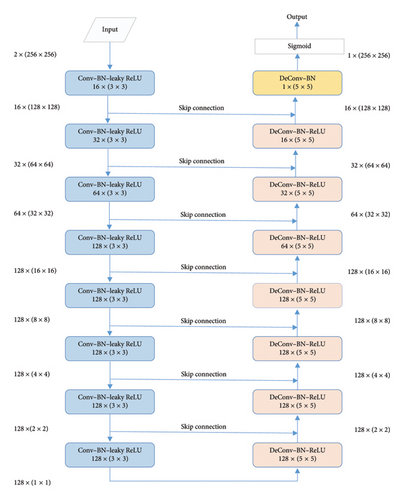
3.1.2. The Embedding Simulator
3.1.3. Architecture of the Discriminator D
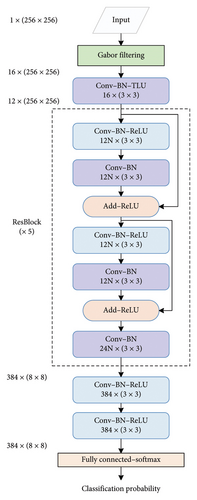
After the preprocessing layer, a Conv block that consists of a truncated linear unit (TLU) [39] is used. The TLU limits the numerical range of the feature map to (-T, T) to prevent large values of input noise from influencing unduly the weight of the deep network, and we set T = 8. After that, five residual blocks are used to extract the features. The structure of each residual block is a sequence consisting of Conv layers, BN layers, and ReLU activation functions. Finally, after two Conv layers and a fully connected layer, the networks produce a classification probability from a softmax layer.
3.1.4. The Loss Function
3.2. SI Estimation–Aided JPEG Steganography
In this part, we will introduce the CNN–based SI architecture and the strategy to asymmetrically adjust the embedding cost according to the estimated SI.
3.2.1. SI estimation
The architecture of the SI estimation is shown in Figure 4. It is composed of two steps: training the CNN–based precover estimation model, and calculating the SI using the trained model.
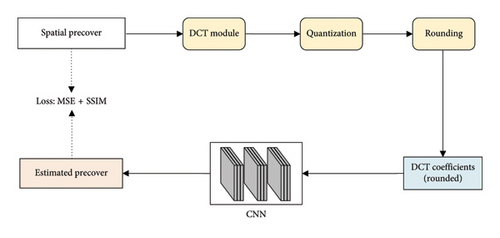
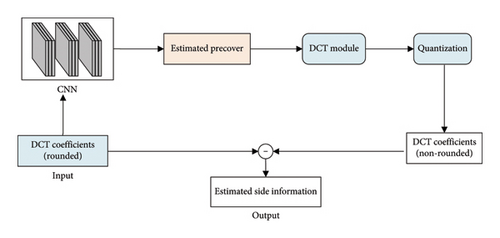
The calculation process of the SI is shown in Figure 4(b). After training the model of the precover estimation network, we can obtain the estimated precover from the input-rounded DCT coefficients and then calculate the nonrounded DCT coefficients. The difference between the rounded DCT coefficients and the DCT coefficients without the rounding operation is used as the SI. The details of the CNN–based precover estimation architecture are shown in Figure 5. It is composed of a series Conv layer, BN layer, and ReLU layer. All the Conv layers employ 5 × 5 kernels with Stride 1.
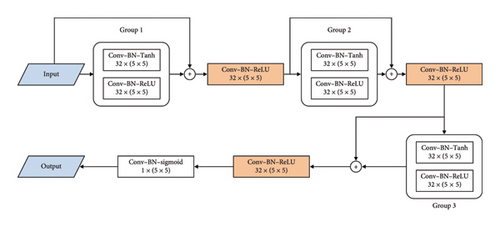
3.2.2. Adjusting the Embedding Cost
4. Experimental Results
In this section, we will describe the details of the experimental setup and introduce adaptive learning. Then, we will present the details of adjusting the embedding cost according to the SI. Finally, we will show our experimental results under three different quality factors (QFs) with different payloads.
4.1. Experimental Setup
The experiments were conducted on SZUBase [23], BOSSBase V 1.01 [39], and BOWS2 [40], which contain grayscale images of size 512 × 512. All of the cover images were first resampled to size 256 × 256, and the corresponding quantified DCT matrix was obtained using JPEG transformation with a QF of 75. SZUBase, with 40,000 images, was used to train the JS–GAN and the CNN–based precover estimation model. In the training phase, all parameters of the generator and discriminator were first initialized from a Gaussian distribution. Then, we trained the JS–GAN using the Adam optimizer [32] with a learning rate of 0.0001. The batch size of the input-quantified DCT matrix of the cover image was set to 8.
After a certain number of training iterations, we used the generator and STC encoder [1] to produce the stego images from 20,000 cover images in BOSSBase and BOWS2 for evaluation. Four steganalyzers, including the conventional steganalyzers DCTR [7] and GFR [6], as well as the CNN–based steganalyzer J-XuNet [16] and SRNet [18], were used to evaluate the security performance of JS–GAN. To train the CNN–based steganalyzer, 10,000 cover–stego pairs in BOWS2 and 4000 pairs in BOSSBase were chosen. The other 6000 pairs in BOSSBase were divided into 1000 pairs as the validation set and 5000 pairs for testing. The training stage of JS–GAN was conducted in TensorFlow V 1.11 with an NVIDIA TITAN Xp GPU card.
4.2. The Content-Adaptive Learning of JS–GAN
We trained the JS–GAN for 60 epochs under the target payload of 0.5 bpnzAC and QF 75. The best model according to the attack results with GFR was selected. Then stegos with payloads of 0.1–0.5 bpnzAC were generated by using a STC encoder according to the cost calculated from the best model trained under 0.5 bpnzAC.
To verify the content-adaptivity of our method, we show the embedding probability map produced by the generator trained after different epochs in Figure 6. The embedding probability generated by J-UNIWARD [2] with the same payload is also given in Figure 6(b) for visual comparison. As shown in Figure 6, the 8 × 8 block property of the embedding probability has been automatically learned. The global adaptability (interblock) and the local adaptability (intrablock) have improved with an increase in the number of training epochs. After 50 training epochs, the block in the complex region has a large embedding probability, which verifies the global adaptability. Inside the 8 × 8 block, the larger probabilities are mostly located in the top left low-frequency region, which proves the local adaptability of JS–GAN. It can be also seen that the embedding probability generated by our GAN–based method has similar characteristics to those generated by J-UNIWARD.

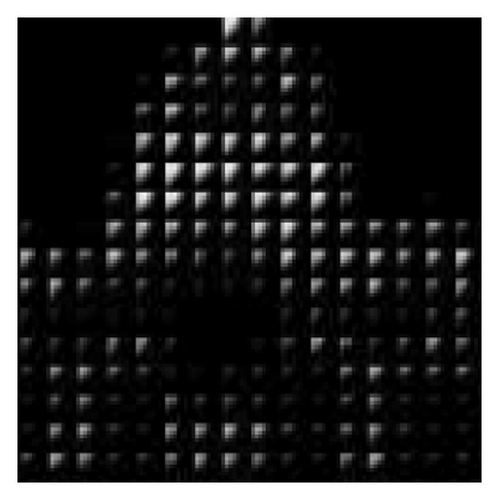
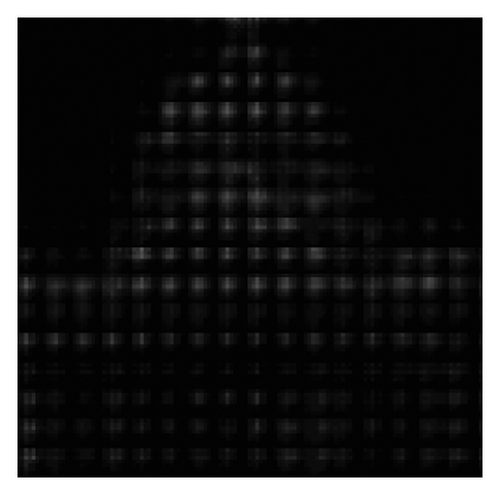
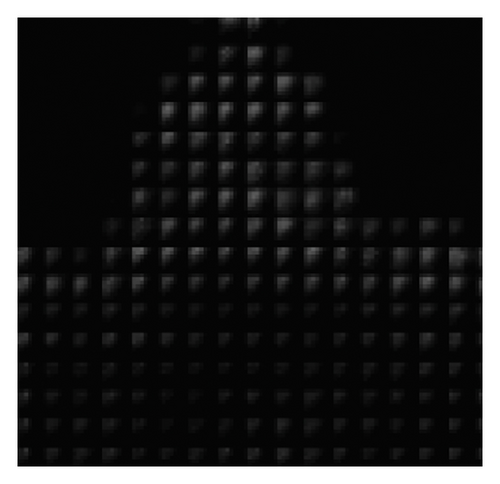
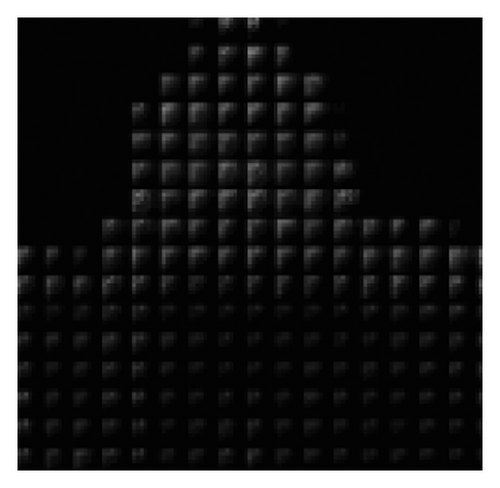
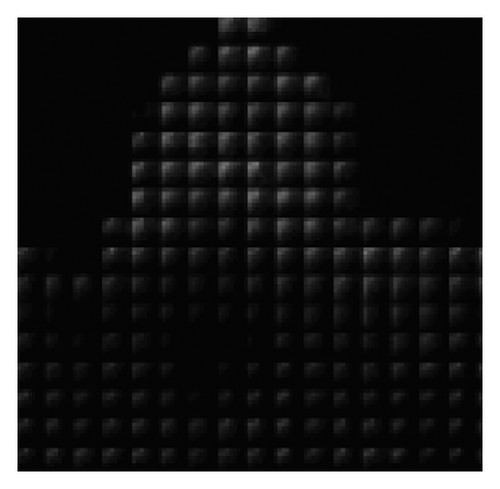
4.3. Parameter Selection for Adjusting the Embedding Cost
We conducted experiments with ESI–aided version JS–GAN (JS–GAN [ESI]) with 0.4 bpnzAC and a QF of 75 to select the proper parameters for asymmetric embedding. The error rate PE of the steganalyzers is used to quantify the security performance of our proposed framework. The error rate detected by GFR with an ensemble classifier is used to evaluate the performance. First, we investigate the impact of the sign of the ESI . Then, we set the amplitude parameter δ = 0 and observe the effect of the polarity parameter η in equation (26)
The effect of η is shown in Table 1, where η = 1 denotes the original JS–GAN, where the cost of +1 is equal to the cost −1. Experimental results show that the performance would be improved when η decreases. Thus, the performance can be improved by adjusting the cost asymmetrically according to the sign of the ESI. From Table 1, the detection error rate of JS–GAN (ESI) increases by 7.85% with η = 0.65 compared to the original JS–GAN.
| η | 0.55 | 0.6 | 0.65 | 0.7 | 0.75 | 0.8 | 1 |
|---|---|---|---|---|---|---|---|
| Error rate | 0.2554 | 0.2607 | 0.2785 | 0.2784 | 0.2758 | 0.2622 | 0.2 |
- Note: The best results are highlighted in bold.
After putting η = 0.65, we further investigated the influence of the parameter δ by using the polarity and the amplitude of the SI at the same time. It can be seen from Table 2 that setting δ = 0.05 will achieve better performance than other values; it also can improve the performance about 10% over setting δ = 0.5, which was used in [30]. The experimental results show that only a small amplitude can be used to improve the security performance. This is because amplitudes close to 0.5 are not precise. It can also be seen that setting δ = 0.05 will lead to an improvement by about 3.4% over δ = 0, and this shows that using the amplitude properly can further improve the performance over using only the polarity of the SI. From Tables 1 and 2, we set η = 0.65 and δ = 0.05 for the final version JS–GAN (ESI).
| δ | 0 | 0.01 | 0.05 | 0.1 | 0.15 | 0.2 | 0.4 | 0.5 |
|---|---|---|---|---|---|---|---|---|
| Error rate | 0.2785 | 0.2829 | 0.3125 | 0.2969 | 0.2944 | 0.2954 | 0.2799 | 0.2132 |
- Note: The best results are highlighted in bold.
4.4. Results and Analysis
We selected the classic steganographic algorithms UERD and J-UNIWARD to make a comparison with our proposed methods JS–GAN and JS–GAN (ESI). For a fair comparison, all steganographic algorithms used the STC encoder to embed the messages. Four different steganalyzers were used to evaluate the performance, including the conventional steganalyzers GFR and DCTR, as well as the CNN–based steganalyzers J-XuNet and SRNet.
The experimental results for JPEG-compressed images with QF 75 are shown in Table 3 and Figure 7. From Table 3, it can be seen that under the attack of the conventional steganalyzer GFR, our proposed architecture JS–GAN can obtain better security performance than the conventional methods UERD and J-UNIWARD. For example, under the attack of GFR with 0.4 bpnzAC, the JS–GAN can achieve a better performance by 2.51% and 2.58% than UERD and J-UNIWARD, respectively. Under the attack of the CNN–based steganalyzer SRNet with 0.4 bpnzAC, the proposed JS–GAN can increase the detection error rate by 3.29% and 0.44% over UERD and J-UNIWARD, respectively.
| Steganalyzer | Steganographic scheme | Payload | ||||
|---|---|---|---|---|---|---|
| 0.1 bpnzAC | 0.2 bpnzAC | 0.3 bpnzAC | 0.4 bpnzAC | 0.5 bpnzAC | ||
| GFR | JS–GAN (ESI) | 0.4720 | 0.4220 | 0.3707 | 0.3125 | 0.2537 |
| JS–GAN | 0.4400 | 0.3650 | 0.2826 | 0.2000 | 0.1283 | |
| UERD | 0.4273 | 0.3351 | 0.2468 | 0.1749 | 0.1126 | |
| J-UNIWARD | 0.4393 | 0.3488 | 0.2568 | 0.1742 | 0.1090 | |
| DCTR | JS–GAN (ESI) | 0.4799 | 0.4474 | 0.4084 | 0.3529 | 0.2848 |
| JS–GAN | 0.4572 | 0.3916 | 0.3123 | 0.2303 | 0.1528 | |
| UERD | 0.4575 | 0.3871 | 0.3137 | 0.2390 | 0.1690 | |
| J-UNIWARD | 0.4655 | 0.4011 | 0.3238 | 0.2492 | 0.1701 | |
| J-XuNet | JS–GAN (ESI) | 0.4053 | 0.3030 | 0.2232 | 0.1622 | 0.1147 |
| JS–GAN | 0.4079 | 0.2873 | 0.1859 | 0.1331 | 0.0834 | |
| UERD | 0.3256 | 0.1923 | 0.1122 | 0.0709 | 0.0459 | |
| J-UNIWARD | 0.3977 | 0.2750 | 0.1821 | 0.1166 | 0.0752 | |
| SRNet | JS–GAN (ESI) | 0.3268 | 0.2142 | 0.1417 | 0.0902 | 0.0618 |
| JS–GAN | 0.3085 | 0.1867 | 0.1114 | 0.0640 | 0.0292 | |
| UERD | 0.1949 | 0.0865 | 0.0446 | 0.0311 | 0.0143 | |
| J-UNIWARD | 0.2971 | 0.1771 | 0.1016 | 0.0596 | 0.0311 | |
- Note: The best results are highlighted in bold.
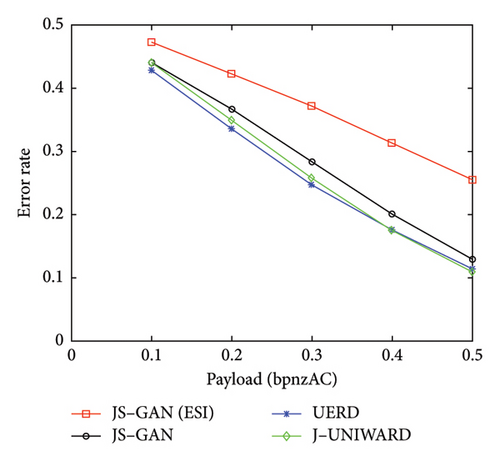
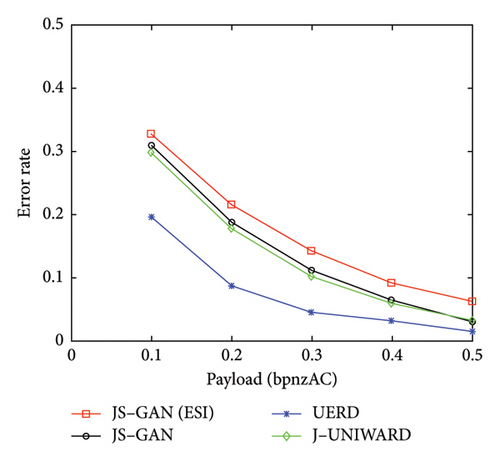
It can be seen from Table 3 that the security performance of JS–GAN can be further improved significantly by incorporating the proposed SI estimated method. With the payload 0.4 bpnzAC, the JS–GAN (ESI) can increase the detection error rate by 11.25% over JS–GAN against the conventional steganalyzer GFR, and it can also increase the detection error rate by 2.62% over JS–GAN to protect against the attack of the CNN–based steganalyzer SRNet. The main reason for the high level of security achieved is mainly because the embedding preserved the statistical characteristics of the precover.
Compared to the conventional methods UERD and J-UNIWARD, a significant improvement can be observed in UERD and J-UNIWARD, respectively. Under the detection of GFR with the payload 0.4 bpnzAC, the detection error of JS–GAN (ESI) is increased by 13.76% and 13.83% over that of UERD and J-UNIWARD, respectively. Under the detection of SRNet with the payload 0.4 bpnzAC, the detection error of JS–GAN (ESI) is also up by 5.91% and 3.06% over UERD and J-UNIWARD, respectively.
To verify the proposed method in the face of different compression QFs, we conducted the experiments for JPEG-compressed images with QFs 50 and 95. The parameters of the generator and discriminator with the QFs 50 and 95 were initialized from the trained best model using the QF 75. The experimental results are shown in Tables 4 and 5, respectively. From Table 4, JS–GAN (ESI) achieves significant improvement compared to the other three steganographic algorithms under the attack of different steganalyzers with different payloads, which proves that the proposed method can achieve better security performance. From Table 5, it can be seen that JS–GAN (ESI) can achieve comparable performance with other steganographic algorithms, and it can also be seen that the performance of JS–GAN (ESI) for higher QF needs to be further improved.
| Steganalyzer | Steganographic scheme | Payload | ||||
|---|---|---|---|---|---|---|
| 0.1 bpnzAC | 0.2 bpnzAC | 0.3 bpnzAC | 0.4 bpnzAC | 0.5 bpnzAC | ||
| GFR | JS–GAN (ESI) | 0.4596 | 0.4067 | 0.3392 | 0.2730 | 0.2119 |
| JS–GAN | 0.4222 | 0.3243 | 0.2322 | 0.1524 | 0.0937 | |
| UERD | 0.4110 | 0.3100 | 0.2181 | 0.1421 | 0.0899 | |
| J-UNIWARD | 0.4151 | 0.3104 | 0.2029 | 0.1277 | 0.0735 | |
| DCTR | JS–GAN (ESI) | 0.4688 | 0.4210 | 0.3604 | 0.3036 | 0.2483 |
| JS–GAN | 0.4304 | 0.3360 | 0.2431 | 0.1620 | 0.0982 | |
| UERD | 0.4363 | 0.3560 | 0.2696 | 0.1918 | 0.1287 | |
| J-UNIWARD | 0.4386 | 0.3571 | 0.2710 | 0.1837 | 0.1211 | |
| J-XuNet | JS–GAN (ESI) | 0.4049 | 0.2990 | 0.2144 | 0.1563 | 0.1104 |
| JS–GAN | 0.3701 | 0.2466 | 0.1589 | 0.0977 | 0.0647 | |
| UERD | 0.2983 | 0.1630 | 0.0952 | 0.0554 | 0.0345 | |
| J-UNIWARD | 0.3764 | 0.2361 | 0.1441 | 0.0861 | 0.0514 | |
| SRNet | JS–GAN (ESI) | 0.3266 | 0.2154 | 0.1262 | 0.0804 | 0.0474 |
| JS–GAN | 0.2702 | 0.1491 | 0.0781 | 0.0377 | 0.0188 | |
| UERD | 0.1764 | 0.0782 | 0.0408 | 0.0182 | 0.0178 | |
| J-UNIWARD | 0.2808 | 0.1402 | 0.0732 | 0.0377 | 0.0334 | |
- Note: The best results are highlighted in bold.
| Steganalyzer | Steganographic scheme | Payload | ||||
|---|---|---|---|---|---|---|
| 0.1 bpnzAC | 0.2 bpnzAC | 0.3 bpnzAC | 0.4 bpnzAC | 0.5 bpnzAC | ||
| GFR | JS–GAN (ESI) | 0.4817 | 0.4525 | 0.4122 | 0.3652 | 0.3095 |
| JS–GAN | 0.4783 | 0.4434 | 0.3920 | 0.3382 | 0.2634 | |
| UERD | 0.4754 | 0.4268 | 0.3702 | 0.3072 | 0.2423 | |
| J-UNIWARD | 0.4894 | 0.4549 | 0.4033 | 0.3417 | 0.2791 | |
| DCTR | JS–GAN (ESI) | 0.4868 | 0.4653 | 0.4295 | 0.3859 | 0.3348 |
| JS–GAN | 0.4864 | 0.4599 | 0.4150 | 0.3604 | 0.2877 | |
| UERD | 0.4888 | 0.4597 | 0.4261 | 0.3697 | 0.3093 | |
| J-UNIWARD | 0.4953 | 0.4750 | 0.4450 | 0.3984 | 0.3430 | |
| J-XuNet | JS–GAN (ESI) | 0.4706 | 0.4118 | 0.3340 | 0.2615 | 0.1811 |
| JS–GAN | 0.4752 | 0.4258 | 0.3441 | 0.2735 | 0.1893 | |
| UERD | 0.4295 | 0.3358 | 0.2380 | 0.1773 | 0.1174 | |
| J-UNIWARD | 0.4841 | 0.4434 | 0.3988 | 0.3309 | 0.2689 | |
| SRNet | JS–GAN (ESI) | 0.4344 | 0.3125 | 0.2103 | 0.1364 | 0.0779 |
| JS–GAN | 0.4267 | 0.3043 | 0.2062 | 0.1286 | 0.0723 | |
| UERD | 0.3201 | 0.1980 | 0.1167 | 0.0673 | 0.0478 | |
| J-UNIWARD | 0.4349 | 0.3250 | 0.2347 | 0.1599 | 0.1008 | |
- Note: The best results are highlighted in bold.
5. Conclusion
- 1.
Through an adversarial training between the generator and discriminator, an automatic content-adaptive steganography algorithm can be designed for the JPEG domain. Compared to the conventional heuristically designed JPEG steganography algorithms, the automatic learning method can adjust the embedding strategy flexibly according to the characteristics of the steganalyzer.
- 2.
To simulate the message embedding and avoid the gradient-vanishing problem, a gradient-descent–friendly and highly efficient probability-based embedding simulator can be designed. Experimental results show that the probability-based embedding simulator can contribute to learning the local and global adaptivity.
- 3.
When the original uncompressed image is not available, a properly trained CNN–based SI estimation model can acquire the ESI. The security performance can be further improved dramatically by using asymmetric embedding with the well ESI.
This paper opens up a promising direction in embedding cost learning in the JPEG domain by adversarial training between the generator and the discriminator. It also shows that predicting the SI brings a significant improvement when only the JPEG-compressed image is available. Further investigation could include the following aspects. First, higher efficiency generators and discriminators can be further investigated. Second, the conflict with the gradient-vanishing and simulating the embedding process also have much room for improvement. Third, we have only carried out an initial study using the CNN to estimate the SI, and the asymmetric adjusting strategy deserves further research. Finally, we will further improve the performance under the larger QF 95.
Disclosure
This paper is already published in the pre-print given in the below link “https://arxiv.org/abs/2107.13151” [41].
Conflicts of Interest
The authors declare no conflicts of interest.
Funding
This work was supported in part by the NSFC under Grant no. 62102462/62102100, the Guangdong Basic and Applied Basic Research Foundation under Grant no. 2022A1515010108, the Key Research Platforms and Projects of Universities in Guangdong Province under Grant no. 2024ZDZX1038, and the Research Project ofthe Guangdong Polytechnic Normal University under Grant no. 2021SDKYA127/2022SDKYA027.
Acknowledgments
This work was supported in part by the NSFC under Grant no.62102462/62102100, the Guangdong Basic and Applied Basic Research Foundation under Grant no. 2022A1515010108, the Key Research Platforms and Projects of Universities in Guangdong Province under Grant no. 2024ZDZX1038, and the Research Project of Guangdong Polytechnic Normal University under Grant no. 2021SDKYA127/2022SDKYA027.
Open Research
Data Availability Statement
The data that support the findings of this study are available in BOSS-Base v1.01 at https://dde.binghamton.edu/download/, reference number [39].




